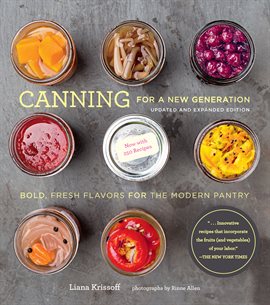Do you have memories of your parents or grandparents canning and preserving and then serving up that food to you? I do. My maternal grandmother canned just about everything. In my turn, I used to can tomatoes and beans. Opening a jar of tomatoes in January (in Minnesota!) was a joy because the entire kitchen smelled of summer for a brief time. Green beans from my small garden were not as popular with the family, unfortunately, but I still canned them for soups. This work made me feel closer to my canning ancestors, who didn’t waste anything and who had to can if they wanted to enjoy summer harvests in the cold winter months.
Want to give it a try? If you don’t have a garden, farmer’s markets are a great source. I know we are through berries and maybe done with green beans. Apples, beets, peaches and corn are still available as well as all of the pickling vegetables. Meat and soups can be canned any time you find a great sale somewhere.
“” is one of the latest versions of a canning standard how-to book. I bought one in 1985 that I still use except for the advice about using paraffin to cover jams and jellies. This book contains the latest recipes as well as today’s best practices for the pressure and time. It covers what can safely be preserved in a water-bath, what low-acid foods must be pressurized, and also has recipes for pickles and chutneys. Yum!
I found a book titled “Put ’em up!” which made me laugh. There was a time when I worked in a very small library and I got to know many of the people who came in. One of these people was a new farmer with several apple trees. She had spent the previous growing season pampering those trees. This year they had thanked her with a healthy crop and on her next visit after harvest, she told me about how many bushels of this or that apple variety she had. I was very happy for her and asked “How many of them did you put back?” Which in my vernacular meant to can or preserve the apples. But she had not heard that before and just looked at me. Like, what?? She asked “What do you mean? I’m keeping all of them!”
 Liana Krissolf is a wryly humorous writer who projects herself into her writings. Her book “Canning for a New Generation” has layers of information and encouragement and personal stories. Plus so many recipes using your preserved foods. It has yummy recipes from around the world, with a shared memory or comment by Krissolf. All of these foods are high acid foods or have added acid so you don’t have to use a pressure cooker. Krissolf clearly describes the water bath canning process and has taken hundreds of pictures of that as well as all of the foods. It’s also a visually appealing book.
Liana Krissolf is a wryly humorous writer who projects herself into her writings. Her book “Canning for a New Generation” has layers of information and encouragement and personal stories. Plus so many recipes using your preserved foods. It has yummy recipes from around the world, with a shared memory or comment by Krissolf. All of these foods are high acid foods or have added acid so you don’t have to use a pressure cooker. Krissolf clearly describes the water bath canning process and has taken hundreds of pictures of that as well as all of the foods. It’s also a visually appealing book.
This canning hobby can be addicting. Every year, our county fairs have rows of preserved jars from people who are putting their tomatoes and beans and pickles in competition with each other. The final book I’m going to share is “Blue Ribbon Canning” by Linda J Amendt. Thumb through the 139 recipes that have won Best of Show and other accolades from the judges. Of course, this is just a place to start — work to develop your own twist on a traditional technique. Good luck!
As you learn to peel, strain and pack things into jars, remember that you are part of an honored tradition of home canning, which started in the early 1900s with the invention of the sealable glass jar. I hope you are inspired to learn more about how to “put back” food to feed yourself and your family.


